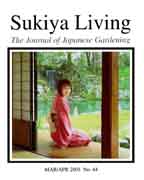|
The Japanese Sword
Curious about how Swords could be related to JN gardens? Read this Article and find out!
Known as katana, the Japanese sword is a weapon that has been heightened to an art form. In its essence, the katanaís key characteristics are: it does not break, it does not bend, and itís very sharp. But the JN swordmakerís pursuit of ultimate sharpness and practicality has also produced a stunning by-product: a tool of remarkable beauty.
Among the three functional characteristics mentioned above, the first two are tough to achieve at the same time. The higher a steelís carbon content, the harder and more brittle it is. A hard steel wonít bend, but it can break like a razor blade. A soft steel wonít break, but it will bend like a wire. To overcome this dilemma, Japanese swords have a softer steel core called shin-gane that is surrounded by harder steel called kawa-gane. In addition to this, one edge of the kawa-gane is professionally sharpened to create a razor-sharp cutting blade.
The steel used for the sharp edge of the blade is called tama-hagane. This
steel contains a very small amount of phosphorus and sulfur. It is made
through a relatively low-temperature, slow reduction process. Tama-hagane is
rare and expensive, and each swordsmith mixes in at least some lesser
quality iron, giving each sword a slightly different texture and look.
Japanese swords have changed over time. It was during the Heian Period that
a curved sword similar to the katana first appeared. Many basic principles
about swordmaking were established at this time, but the Japanese sword has,
in fact, continually changed in length, thickness, and arc to reflect the
needs of each passing era.
The Kamakura era was the golden era for swords because the government was military-based. Kamakura swords were wide and thick. Shorter swords (daggers) also appeared. Later in this era, battle-hardened Mongols attacked Japan twice. To deal with the Mongolsí in-close fighting style, Japanese swords were made less curved and more sturdy. The crisis urged Japan to be serious about weapons and armor. They came to produce more iron, and they developed great swordsmiths like Masamune.
During the first part of the Muromachi Era, yari spears became the main weapon of guerrilla tactics, forcing swords to be longer with a wide point for mowing down enemies. During the second half of the Muromachi era a century-long civil war broke out. During this time the main force of battle shifted from cavalry to infantry. Swords became shorter for carrying on the belt while walking. Short (60cm) swords for one-hand use became popular. A great number of swords were made during this era, and distinctive differences can be seen between specimen swords and mass produced ones.
As the Edo-era government became more stable, samurai were forced to live as bureaucrats, and their swords became symbols rather than weapons. New customers for swordsmiths were the wealthy merchants, and the aesthetics of swords and sword accessories became more important than their function. This period produced many famous craftsmen and schools of sword accessories.
During the Meiji era, civilians were forbidden to carry swords in public. Many people still kept prized swords in their homes and kura warehouses, but the making of new swords nearly ceased.
Nowadays people can own registered swords, but it has become a dying art. There are very few swordmakers and sword-quality steel refineries in Japan. One ironworks is located in Yasugi, the same town where the Adachi Museum of Art is located. This ironworks was built shortly after WWII by civilian sword enthusiasts in an effort to preserve the skills and knowledge of senior metal workers. They now have a museum at the foundry, and you can watch firsthand the iron refining and swordmaking processes.
So what is the connection between swordmaking and gardening? After the war-torn Muromachi Era, many sword makers went into related fields such as the making of gardening tools, cooking knives, and woodworking tools. This transformation of knowledge and technology broadened the capabilities of many industries.
During the peaceful Edo period people had more time and money to invest in their houses, gardens, arts and beautiful crafts. These years saw Japanís metalworking tradition contribute to the development of fine carpentry techniques and the sukiya style of architecture. Advanced woodcutting tools allowed woodblock print artists to produce their masterpieces. And top-notch gardening tools allowed aesthetic pruning to emerge center stage in the tradition of landscape gardening.
The adaptation of military and scientific technology to new uses is a common theme in world history. Japanís extra emphasis on aesthetics make the Japanese sword a particularly compelling blend of industrial skill and fine art.
